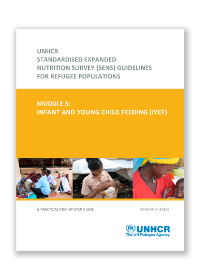OBJECTIVES
The objective of the IYCF module (Module 3) is:
- To investigate IYCF practices among children 0-23 months.
INDICATORS
Module 3 aims to measure the following priority indicators:
- Timely initiation of breastfeeding in children aged 0-23 months (meaning children aged 0 to <24 months)
- Exclusive breastfeeding under 6 months (meaning children aged <6 months)
- Continued breastfeeding at 1 year in children aged 12-15 months (meaning children aged 12 to <16 months)
- Continued breastfeeding at 2 years in children 20-23 months (meaning children aged 20 to <24 months)
- Introduction of solid, semi-solid or soft foods in children aged 6-8 months (meaning children aged 6 to <9 months)
- Consumption of iron-rich or iron-fortified foods in children aged 6-23 months (meaning children aged 6 to <24 months)
- Bottle feeding in children aged 0-23 months (meaning children aged 0 to <24 months)
KEY MESSAGES
- UNHCR supports the policy of the World Health Organization (WHO) concerning safe and appropriate infant and young child feeding, in particular by protecting, promoting and supporting exclusive breastfeeding for the first six months of life and continued breastfeeding for two years or beyond, with timely and correct use of adequate complementary foods. The use of milk products in refugee settings must conform to the UNHCR milk policy.
- Breastfeeding guarantees food and fluid security in infants for the first six months and provides active immune protection and remains a significant source of energy, nutrients and protection up to two years and beyond.
- Breastfeeding is an unequalled way of providing complete hygienic food for the healthy growth and development of infants, and forms a unique biological and emotional basis for the health of both mother and child. In addition, the active anti-infective properties of breastmilk help to protect infants against disease, and there is an important relationship between exclusive breast-feeding and child spacing. Breastmilk alone (exclusive) satisfies the nutritional and fluid requirements of an infant for the first complete six months of life in all settings and climates. After six months, adequate and appropriate infant complementary foods become necessary to complement breastmilk in order to meet the energy and other nutrient requirements of the infant (timely complementary feeding). Breastmilk remains a significant source of energy, nutrients and protection up to two years and beyond.
- Infant and young child feeding practices directly affect the nutritional status of children under two years of age and, ultimately, impact child survival. Protecting, and where necessary improving on, infant and young child feeding practices in children aged 0-23 months of age is therefore critical to improved nutrition, health and development of children. Infants and young children who are not breastfed – temporarily or longterm – need early identification and appropriate support to minimise risks.
- The inclusion of this IYCF module in routine nutrition surveys will provide information on some priority IYCF indicators among children 0-23 months. If a more detailed analysis of IYCF is needed to assess programme impact, it is recommended to implement a stand-alone IYCF survey using the CARE guidelines (January 2010).
- The majority of questions for this IYCF module are taken from the WHO and CARE Guidelines on IYCF that seek to harmonise the surveys undertaken in the sector. The harmonisation of survey instruments and survey design allows for comparison e.g. between national populations and refugee populations. Providing good quality training to survey teams and supervising them well will help ensure that data are reliable.
- Standard questionnaires should be used for the collection of IYCF indicators and the exact same questions and number of questions should be asked from year to year to allow direct comparisons of results. The questions on liquids and foods should be adapted to the local context (the wording of the actual questions should not be changed). Attention to accurate estimation of age is critical for quality indicator measurement.
- There are standard ways of reporting IYCF indicators that should be followed in all nutrition survey reports produced in refugee contexts.
CAUTION!
When IYCF indicators are collected in nutritional surveys based on GAM in children aged 6-59 months, it is not feasible to achieve a large enough sample size for some of the indicators to be estimated as precisely as desired, especially for indicators covering a very narrow age range (e.g. 6-8 months, 12-15 months, 20-23 months). Nevertheless, including this IYCF module in the nutrition survey will provide trend data from year to year for certain priority indicators to monitor programme performance (see Results section) and will flag major problems with IYCF which need further investigation. The confidence intervals are an integral part of the results in this IYCF module.
Downloads

